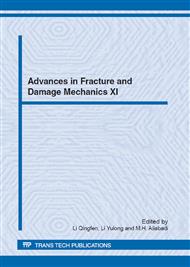p.169
p.173
p.177
p.181
p.185
p.189
p.193
p.197
p.201
Deterioration of FRC Plate due to Explosion and Change of Temperature
Abstract:
Recently it was shown that the temperature plays very important role in coupling with the impact of shock wave caused by explosion in a free space. The deterioration of fiber reinforced concrete structures, FRC, at the face to which the main impact of the coupled load is directed is not easy to describe. In couple of previous papers of the author the problem was solved under condition that the structure behaves elastically. It appeared that a numerical tool known as free hexagon method, which is based on soft contact problem in combination with boundary elements, seems a powerful approach solving any disconnecting media. The soft contact is identified by nonlinear spring rules. Similar idea is used in the suggested paper for solving the coupled problem envisaged, but the mesh of free hexagons is split into the air and the structure. If the impact of explosion and the subsequent shock wave cause is viewed separately from the changes in material due to temperature a very fast changes in stresses and movements in material are observed in the first case while the changes due to temperature develop much slower. On the other hand in combination of both influences the temperature increase the activity inside of structures considerably. In the paper the theory is briefly described and selected examples illustrate the mobility of the application of the method to a problem of FRC plate.
Info:
Periodical:
Pages:
185-188
Citation:
Online since:
November 2012
Authors:
Price:
Сopyright:
© 2013 Trans Tech Publications Ltd. All Rights Reserved
Share:
Citation:


